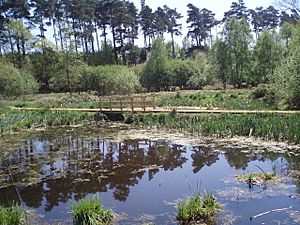Sandlings Forest facts for kids
| Site of Special Scientific Interest | |

Pond in Rendlesham Forest
|
|
| Area of Search | Suffolk |
|---|---|
| Interest | Biological |
| Area | 2,483.8 hectares |
| Notification | 2000 |
| Location map | Magic Map |
Sandlings Forest is a very special natural area in Suffolk, England. It covers a large space of about 2,483 hectares, which is like having over 3,400 football fields! This forest is made up of two main parts, Rendlesham Forest and Tunstall Forest, plus two smaller areas. You can find it between the towns of Woodbridge and Aldeburgh.
Sandlings Forest is officially known as a "Biological Site of Special Scientific Interest" (SSSI). This means it's a place with important plants, animals, or geology that needs to be protected. It's also part of the Sandlings Special Protection Area (SPA), which is a special zone for protecting wild birds, following rules from the European Union. Plus, it's located within the beautiful Suffolk Coast and Heaths Area of Outstanding Natural Beauty, a place recognized for its amazing landscapes.
Contents
Why Sandlings Forest is Special
Sandlings Forest is a really important place for wildlife, especially birds. Even though it's a commercial forest with lots of planted trees, it provides a perfect home for some rare and special birds.
Home to Rare Birds
The main reason Sandlings Forest is protected is because of its amazing bird populations. Experts have studied the forest and found many important birds living there.
Nightjars and Woodlarks
In the 1990s, surveys showed that Sandlings Forest was home to 81 singing nightjars. This was about 2% of all the nightjars in Britain! Nightjars are cool birds that are active at night. The forest also had 71 woodlarks, which was about 5% of all the woodlarks in Britain. Woodlarks are known for their beautiful songs. These numbers show how vital Sandlings Forest is for these special birds.
Exploring Sandlings Forest
Even though Sandlings Forest is a protected area, you can still visit and explore parts of it. There are public footpaths that go through the woods. These paths allow people to enjoy the nature and perhaps even spot some of the amazing birds that live there, while making sure the wildlife is not disturbed.

